Stop Creditor Harassment and Discharge Debt: Usually filing for bankruptcy puts an automatic stay on most collection activities. This allows our lawyers to prevent creditors from making harassing phone calls, work to get your repossessed property returned , and put a stop on wage garnishments.
Depending on which chapter is filed, most types of debt can be eliminated. Our lawyers work with your creditors to do away with medical bills and credit card debt. We offer valuable advice and assistance for clients concerned about student loans and expenses.
Protect Yourself From Unethical Practices: A few precautionary notes: Watch out for lawyers who claim to be “experienced,” but are actually new to bankruptcy law practice, although they may be experienced in other areas. Likewise, watch out for mortgage industry agencies that do not have your best interests at the heart of their lending practices. Finally, watch out for unscrupulous debt counseling, debt settlement or debt consolidation enterprises that create problems rather than providing true debt relief. Ledford, Wu & Borges, LLC has the level of experience and the genuine answers that our clients seek.
As a leading Chicago Bankruptcy Law Firm, our lawyers have more than 50 years of bankruptcy experience that we utilize to help you eliminate debt in Chicago and its suburbs. Our focus is on bankruptcy and only bankruptcy, which makes us highly familiar with local regulations, trustees, judges and creditors.
The Bankruptcy Process
Bankruptcy issues can be confusing and financial warning signs can grow into bigger problems quickly. That is why we lay out a timeline designed for your situation. From choosing the right Chicago bankruptcy attorney to rebuilding your credit after filing , we answer all your questions and can help you decide if filing bankruptcy is right for you .
Chapter 7
Receive a fresh start by discharging all of your eligible debt.
Chapter 13
Individuals who can afford to pay some of their debt back can establish a repayment plan with Chapter 13 bankruptcy.
Chapter 11
Also known as “business reorganization bankruptcy,” Chapter 11 permits a company to set up a repayment schedule, allowing for the retention of professional relationships and continuation of business operations.
Chapters 9, 12, and 15
These chapters deal with bankruptcy options for farmers, fishermen, municipalities and cross-border cases.
Life After Bankruptcy
Foreclosure Assistance: If you want to prevent a foreclosure , filing for bankruptcy may be an option that could save your house. Our lawyers will provide you with the foreclosure information you require.
